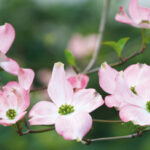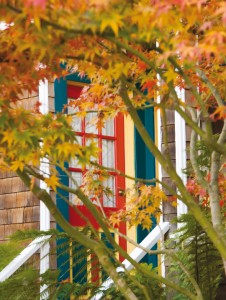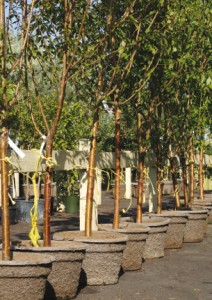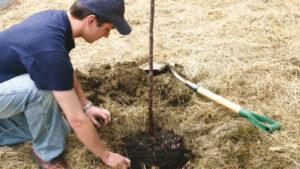Putting Down Roots: Tree-planting Basics
 You’ve worked hard all summer to get your yard the way you like it. You’ve watered, fertilized and pruned. Your trees are healthy and happy—and now it’s time to start afresh.
You’ve worked hard all summer to get your yard the way you like it. You’ve watered, fertilized and pruned. Your trees are healthy and happy—and now it’s time to start afresh.
“Whoa,” you say, “I’ve spent all summer at this! Don’t throw in something new!”
While planting new trees may be far from your mind now, fall is actually one of the best times to plant deciduous trees—those that lose their leaves, flowers or fruits for part of the year. Many people are enticed to plant in the spring, however, when the nurseries set out all their new displays, everything is in bloom and their neighbors are sprucing up their yards with their new finds. But fall plantings do best, says Richard Jones, a certified arborist.
Most popular deciduous landscape trees for Zone 7 (Roanoke Valley)
Hybrid Poplar • Weeping Willow • Japanese Red Maple • Sugar Maple • Red Maple • Eastern Redbud • Japanese Cherry • Paper Birch • Smoketree • Quaking Aspen • Tuliptree (Yellow Poplar) • Camellia • Saucer Magnolia • Red Dogwood • Thornless Honeylocust • Prairifire Flowering Crab • Purpleleaf Sand Cherry
Source: Arbor Day Foundation; these trees are available for purchase at arborday.org, along with nearly 200 popular landscape trees.
“Plant in the fall because the tree’s going dormant,” says Jones. “All the energy is going to the roots.” With more moisture and cooler temperatures, trees have a better chance of getting used to their new home. “The tree has all winter to get its roots acclimated, to get started,” he says.
 There are many reasons to plant new trees, apart from adding more beauty to your yard. In maturity, larger varieties can provide shade to cool your home in the summer and a barrier to shield it in the winter against those harsh, cold winds. Trees clean the air, prevent soil erosion, provide fruits and nuts and, for the investment-minded homeowner, can increase the value of your property up to 25 percent, according to the Tree Care Industry Association. And the value of being able to watch one of your own projects take root, blossom and grow? As the credit card commercial says: priceless!
There are many reasons to plant new trees, apart from adding more beauty to your yard. In maturity, larger varieties can provide shade to cool your home in the summer and a barrier to shield it in the winter against those harsh, cold winds. Trees clean the air, prevent soil erosion, provide fruits and nuts and, for the investment-minded homeowner, can increase the value of your property up to 25 percent, according to the Tree Care Industry Association. And the value of being able to watch one of your own projects take root, blossom and grow? As the credit card commercial says: priceless!
Once you’ve decided to plant a new tree, choosing what to plant can be a challenge. In Virginia, we have many options, and the Internet can help your decision-making process. At ArborDay.org, you will find a Tree Guide with information on height and spread, soil and sun requirements, leaves and fruit, history and more. The Urban Forest Ecosystems Institute also has a SelecTree guide (selectree.calpoly.edu) that is searchable by name and attribute.
Jones, who helps coordinate Arbor Day for the city of Lynchburg each April, says the smaller flowering trees, such as crape myrtles, are always popular. “It’s quick and you get to see them [mature] in your lifetime,” he says. But he does warn against one variety—the popular Bradford Pear—because although its blooms are always beautiful, their lifespan is short. “They have a fault with their branch attachment; in 15–20 years they fall apart,” he says. “I see that tree finally going away.”
Planting for the long term is what Jones prefers—the larger trees, such as new elms and oaks. “They are trees that I might not live long enough to sit under the shade of, but that’s OK. People should plant more of those.”
There are many factors to keep in mind. Though our regional climate may be predictable, everyone’s yard is different. Just as generals strategize on the battlefield, gardeners must carefully plan their tree’s location. Too close to a patio, driveway or other hardscape can cause root damage. Too close to a building can cause damage to the structure itself (TreePeople, an environmental nonprofit, suggests staying at least 10 to 15 feet away from your home’s foundation and at least 5 feet from fences, patios and other structures). And, too close to utility lines can cause a safety hazard to you and your family. (Experts recommend contacting your utility company before planting a tree in your yard.) Knowing the size, spread and shape of a mature tree is of utmost importance. The Arbor Day Foundation has developed a “Right Tree in the Right Place Quiz” (arborday.org/trees/righttreeandplace/), which is a fun way to determine which variety is the best match for your yard.
 You will also find information on trees for our hardiness zone—Zone 7. (In the United States and Canada, there are 11 plant hardiness zones, which are divided based on a 10-degree Fahrenheit difference in the average annual minimum temperature.) The Arbor Day website, which includes a map and detailed information, says to “keep in mind that local variations such as moisture, soil, winds, and other conditions might affect the viability of individual plants” and to call on a local professional arborist or nursery for specific information on planting and nurturing certain varieties.
You will also find information on trees for our hardiness zone—Zone 7. (In the United States and Canada, there are 11 plant hardiness zones, which are divided based on a 10-degree Fahrenheit difference in the average annual minimum temperature.) The Arbor Day website, which includes a map and detailed information, says to “keep in mind that local variations such as moisture, soil, winds, and other conditions might affect the viability of individual plants” and to call on a local professional arborist or nursery for specific information on planting and nurturing certain varieties.
No matter what tree you decide to adopt as your own, you may find yourself wondering how to “put down those roots.” After all, you want to start your young ‘un off on the right foot.
Soil preparation before planting is crucial, Jones says. With the heavy clay soil we have here, “you can’t dig a hole just big enough for the root ball; it needs to be three, four, five times as big. The soil really needs to be loosened and turned as big around as you can, to break up that hard, clay soil. Some people say you almost have to work a garden to plant a tree in this clay soil.”
Trees usually come in one of two ways: containers (pots) or balled and burlapped. According to Jones, most retailers are selling containers now, mainly because the market has demanded something easier for homeowners to handle. While the trees usually come with instructions, he says the most common mistake people make when planting them is digging the hole too deep, damaging the “root collar” at the base of the tree. Jones warns, “If it goes below the ground, it will kill a tree.”
A second mistake homeowners make is overwatering. Everyone knows plants need water, and a good soaking is welcomed by any newly planted tree, but continual heavy watering does more harm than good. “Generally homeowners overwater, trying to do a good thing,” Jones says. But trees only need 5 to 10 gallons a week, “and people are out there watering it every day because they want to help that tree grow.”
Where people can’t really make a mistake with nurturing a new tree is mulching. Any kind of mulch—whether simple wood chips or the dyed, moist mulch that is more pleasing to the eye—stacked around the base is good, Jones says. Mulch keeps the ground cooler, holds in moisture and keeps weeds out.
So with a solid trunk of knowledge for planting new trees, branch out and take hold of all the fall season has to offer—including adding new towering gifts of nature to your yard.
 Planting tips from the Virginia Department of Forestry
Planting tips from the Virginia Department of Forestry
CONTAINER TREES: Trees packaged this way require you to do some root inspection and adjustment. Remove the tree from the container and use your fingers or a blunt instrument to carefully pry the fine roots away from the ball mass and spread them out.
BALLED AND BURLAPPED TREES: Dig a hole at least three times the diameter of the root ball. Cut away the burlap (especially if it is synthetic or plastic material) and remove any string or twine. Lift the tree by the ball (never the trunk) and place the root ball in the hole. Place backfill soil (such as combinations of peat moss, composted manure, and topsoil) in the hole up to the height of the ball or slightly lower so it can settle.






